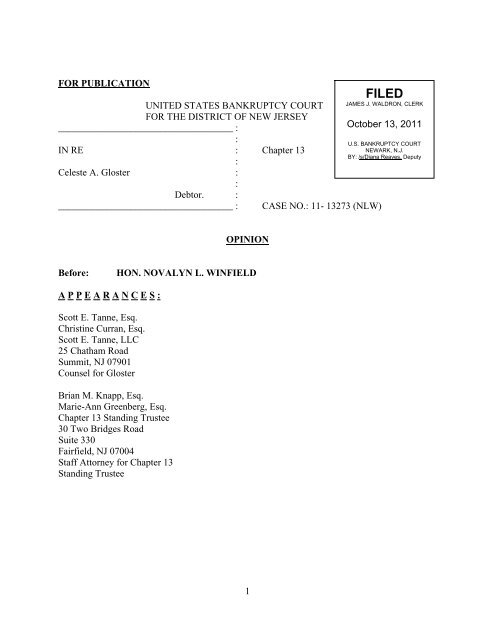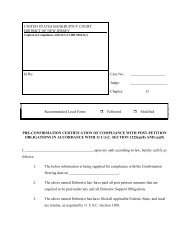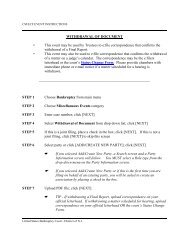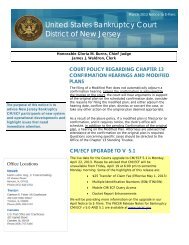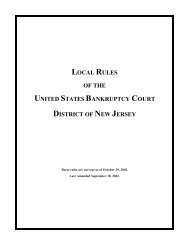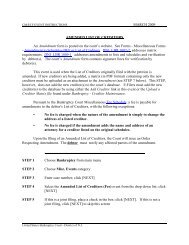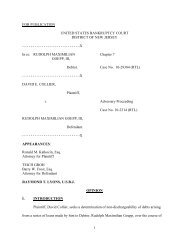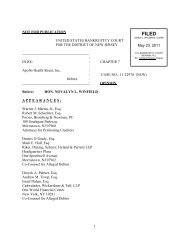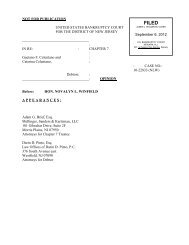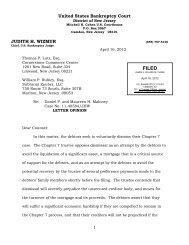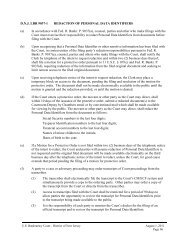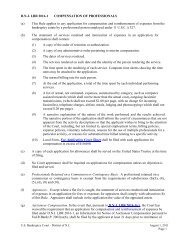In re Gloster Lien Stripping, case no - United States Bankruptcy ...
In re Gloster Lien Stripping, case no - United States Bankruptcy ...
In re Gloster Lien Stripping, case no - United States Bankruptcy ...
You also want an ePaper? Increase the reach of your titles
YUMPU automatically turns print PDFs into web optimized ePapers that Google loves.
FOR PUBLICATIONUNITED STATES BANKRUPTCY COURTFOR THE DISTRICT OF NEW JERSEY____________________________________ ::IN RE : Chapter 13:Celeste A. <strong>Gloster</strong> ::Debtor. :____________________________________ :CASE NO.: 11- 13273 (NLW)FILEDJAMES J. WALDRON, CLERKOctober 13, 2011U.S. BANKRUPTCY COURTNEWARK, N.J.BY: /s/Diana Reaves, DeputyOPINIONBefo<strong>re</strong>:HON. NOVALYN L. WINFIELDA P P E A R A N C E S :Scott E. Tanne, Esq.Christine Curran, Esq.Scott E. Tanne, LLC25 Chatham RoadSummit, NJ 07901Counsel for <strong>Gloster</strong>Brian M. Knapp, Esq.Marie-Ann G<strong>re</strong>enberg, Esq.Chapter 13 Standing Trustee30 Two Bridges RoadSuite 330Fairfield, NJ 07004Staff Attorney for Chapter 13Standing Trustee1
The issue raised by the Chapter 13 Trustee in the <strong>case</strong> described below is whether adebtor who is ineligible for a Chapter 13 discharge pursuant to <strong>Bankruptcy</strong> Code § 1328(f) mayobtain confirmation of a Chapter 13 plan that provides for the strip-off of a wholly unsecu<strong>re</strong>djunior lien. As set forth below, the Trustee’s objections a<strong>re</strong> overruled and the Chapter 13 plan isconfirmed.This court has jurisdiction to consider this matter pursuant to 28 U.S.C. §§ 1334 and157(a) and the Standing Order of Refe<strong>re</strong>nce issued by the <strong>United</strong> <strong>States</strong> District Court for theDistrict of New Jersey on July 23, 1984. This is a co<strong>re</strong> proceeding under 28 U.S.C. §157(b)(2)(A), (K) and (L).BACKGROUNDA. Chapter 7 CaseCeleste A <strong>Gloster</strong> (“Mrs. <strong>Gloster</strong>” or “Debtor”) and her husband filed for <strong>re</strong>lief underChapter 7 of the <strong>Bankruptcy</strong> Code on September 30, 2010. <strong>In</strong> their bankruptcy petition, their<strong>re</strong>sidence was listed as having an estimated value of $182,000. The <strong>re</strong>sidence was listed asencumbe<strong>re</strong>d by a first mortgage held by Chase Manhattan Mortgage (“Chase”) in the amount of$200,200, a second mortgage held by Bank of America (“BOA”) in the amount of $51,171 and ajudgment lien held by BOA in the amount of $6,838. Mrs. <strong>Gloster</strong>’s Chapter 7 <strong>case</strong> was t<strong>re</strong>atedas a <strong>no</strong>-asset <strong>case</strong> and the Trustee’s Report of No Distribution was filed on November 29, 2010.The <strong>Gloster</strong>s <strong>re</strong>ceived their discharge on December 30, 2010.Approximately four months after the Chapter 7 <strong>case</strong> was filed, on February 4, 2011, Mrs.<strong>Gloster</strong> filed for <strong>re</strong>lief under Chapter 13. On the petition, the Debtor’s <strong>re</strong>sidence is again valuedat $182,000 and the secu<strong>re</strong>d claims as to this property a<strong>re</strong> listed as totaling $258,209.00. The2
Chapter 13 Trustee advises that the valuation of her <strong>re</strong>sidence is based on the same cur<strong>re</strong>ntmarket analysis that was submitted to and <strong>re</strong>lied upon by the Chapter 7 Trustee. BOA did <strong>no</strong>tfile a proof of claim. Only the first mortgagee, Chase, and the <strong>In</strong>ternal Revenue Service filedproofs of claim. The Chase proof of claim <strong>re</strong>flects a total amount due of $226,659.49. Mrs.<strong>Gloster</strong>’s Chapter 13 plan proposed to cu<strong>re</strong> the first mortgage ar<strong>re</strong>ars in the amount of $18,000and strip-off both the second mortgage and judgment lien held by BOA. It appears that BOAwas properly served with the Chapter 13 plan and has <strong>no</strong>t objected to its t<strong>re</strong>atment. The Chapter13 Trustee, however, objected to Mrs. <strong>Gloster</strong>’s plan. The Debtor’s schedules <strong>re</strong>flect excessincome of $389.22, which the Debtor proposed to devote to her Chapter 13 plan for sixtymonths. But, the Chase proof of claim sets forth an ar<strong>re</strong>arage claim of $27,227.52. To deal withthe claim the Debtor’s modified her plan to provide for payments of $389.22 for five months and$575.00 for fifty-five months. These inc<strong>re</strong>ased payments a<strong>re</strong> expected to be met by further<strong>re</strong>ducing expenses and from a <strong>re</strong>duction in the payment due to Chase as a <strong>re</strong>sult of the <strong>re</strong>ductionin the inte<strong>re</strong>st rate.2. Mrs. Closter’s Certification<strong>In</strong> <strong>re</strong>sponse to the Trustee’s objection, and to add<strong>re</strong>ss the court’s concerns, Mrs. <strong>Gloster</strong>submitted a certification that described at g<strong>re</strong>at length the circumstances that caused her to filethe instant Chapter 13 <strong>case</strong>:I purchased my home in June 2001… . It is a detached single family home withone bedroom and one bathroom. The total squa<strong>re</strong> footage is about 800 sq. ft…. .(Certification of Debtor 2)<strong>In</strong> early 2006 an addition was started on the house that would add a<strong>no</strong>therbedroom and bathroom as well as a family room. The final squa<strong>re</strong> footage wasestimated to be at 1,500 sq. ft. To finance the addition, I took out a home equity3
loan on the house with Bank of America. The construction continued for aboutsix to seven months. The<strong>re</strong> hasn’t been any work done since mid-2006.Cur<strong>re</strong>ntly, only the foundation, outer walls, and roof have been e<strong>re</strong>cted, and thewindows have been installed. (Certification of Debtor 3)At the time the construction started, I was cur<strong>re</strong>nt with the first mortgage, and itwas well within the household budget to be able to afford a second mortgagepayment. (Certification of Debtor 4)I am employed as a health ca<strong>re</strong> <strong>re</strong>cruiter and have been in this line of work formo<strong>re</strong> than a decade. I have owned my own business since 1996, the purpose ofwhich was HR consulting and training. <strong>In</strong> July 2006 I left the hospital with whichI had been employed because of a hostile work environment c<strong>re</strong>ated by newmanagement. Based on the success I experienced in my old position and thegood <strong>re</strong>putation I had developed, I believed I could be successful doing the samething with my own company if I dedicated myself to it full time… . (Certificatio<strong>no</strong>f Debtor 5)By early 2007 the business was still <strong>no</strong>t producing the income that I needed o<strong>re</strong>xpected, so I started to look for employment. The jobs that we<strong>re</strong> available at thattime we<strong>re</strong> paying less than the position I had left in July 2006. I took the jobsince I needed the income, but I knew it wasn’t going to be e<strong>no</strong>ugh money tomeet all of my obligations. This job was <strong>no</strong>t a good fit for me, so I left andstarted a new job in April 2007. <strong>In</strong> June 2007 I left this job for a third job,… but Iwas unexpectedly let go from this job. I collected unemployment from January2008 until December 2008, when I was hi<strong>re</strong>d at my cur<strong>re</strong>nt job. (Certification ofDebtor 6)During the time that I was under-employed and unemployed, I feel [sic] behind onmy mortgage payments and other obligations. Through the help of familymembers I was able to become cur<strong>re</strong>nt. I still did <strong>no</strong>t make as much as I didbefo<strong>re</strong> July 2006, <strong>no</strong>r did I earn e<strong>no</strong>ugh to make ends meet, but I managed tojuggle the household expenses until about April 2010, when I once again fellbehind on the mortgage. (Certification of Debtor 7)Lacking the income necessary to catch up on the mortgage or to pay back ourunsecu<strong>re</strong>d debts, my husband and I both needed the <strong>re</strong>lief available throughChapter 7 bankruptcy. Our joint Chapter 7 <strong>case</strong> was filed on September 20, 2010.This <strong>case</strong> was discharged on December 30, 2010. (Certification of Debtor 8)<strong>In</strong> December 2010, I was told that I was being promoted and would be getting araise. <strong>In</strong> January 2011, my paychecks <strong>re</strong>flected the raise. I thought I would beable to keep the house if I applied my raise to catching up on the ar<strong>re</strong>ars. When I<strong>re</strong>viewed my budget, I knew I would have to cut back on some expenses as well4
to make it work. Not wanting to accrue any mo<strong>re</strong> ar<strong>re</strong>ars, on February 4, 2011, Ifiled the instant Chapter 13 <strong>case</strong>. (Certification of Debtor 9)Mrs. <strong>Gloster</strong> also states that she is trying to build up her business in hopes of generatingadditional income. (Certification of Debtor 11) Further, Mrs. <strong>Gloster</strong> advises that in June2011 her first mortgage payment was <strong>re</strong>duced to 3.00% from 6.375%, providing some additionalsavings. (Certification of Debtor 11)The Chapter 13 Trustee objects to confirmation of the Debtor’s plan, because theDebtor’s ineligibility for a Chapter 13 discharge p<strong>re</strong>cludes strip-off of the BOA claim.Mo<strong>re</strong>over, the Chapter 13 Trustee contends that the plan was <strong>no</strong>t filed in good faith, because,inter alia, the Chapter 13 <strong>case</strong> was filed only five months after the Debtor filed her Chapter 7<strong>case</strong> and the size of the mortgage ar<strong>re</strong>ars indicates that the Debtor always intended to file aChapter 13 <strong>case</strong> after <strong>re</strong>ceiving her Chapter 7 discharge. <strong>In</strong> other words, the Trustee infers thatthe<strong>re</strong> we<strong>re</strong> <strong>no</strong> changed circumstances that prompted the Chapter 13 filing. Finally, the Trusteeobjects that confirmation of this Chapter 20 <strong>case</strong> provides the Debtor with the opportunity to<strong>re</strong>ceive a g<strong>re</strong>ater benefit than can be accomplished solely from a <strong>case</strong> filed under either Chapter 7or 13.DISCUSSIONA Chapter 13 <strong>case</strong> filed shortly after a Chapter 7 <strong>case</strong> is colloquially described as aChapter 20 <strong>case</strong>. Although <strong>no</strong>t routinely utilized by debtors, Chapter 20 <strong>case</strong>s have been a part ofChapter 13 practice for many years in a number of jurisdictions. <strong>In</strong> 1991 the Sup<strong>re</strong>me Court heldthat a mortgage lien, for which a debtor is <strong>no</strong> longer personally liable as a <strong>re</strong>sult of a Chapter 7discharge, is a claim as that term is defined in the <strong>Bankruptcy</strong> Code, and that claim may be t<strong>re</strong>atedin a Chapter 13 plan. Johnson v. Home State Bank, 501 U.S. 78, 84 (1991). The Johnson5
decision was followed by Nobleman v. Am. Sav. Bank, which examined the language andapplication of §§ 506(a) and 1322(b)(2) to determine that a Chapter 13 debtor can<strong>no</strong>t strip-downa partially unsecu<strong>re</strong>d <strong>re</strong>sidential mortgage lien. 1508 U.S. 324, 328-29 (1993). Left undecided byNobleman was whether a wholly unsecu<strong>re</strong>d mortgage lien on the debtor’s principal <strong>re</strong>sidence fallsoutside of the protection afforded by the § 1322(b)(2) antimodification clause and can bestripped-off. <strong>In</strong> the Third Circuit, this question was answe<strong>re</strong>d in the affirmative by McDonald v.Master Fin., <strong>In</strong>c. (<strong>In</strong> <strong>re</strong> McDonald), 205 F.3d 606 (3d Cir. 2000). 2The 2005 amendments to the <strong>Bankruptcy</strong> Code effected changes to §§ 1328 and 1325 thatcaused courts to question whether a Chapter 20 strip-off of a mortgage lien on a principal<strong>re</strong>sidence <strong>re</strong>mains possible. Section 1328(f)(1) <strong>no</strong>w prohibits a Chapter 13 discharge if the debtor<strong>re</strong>ceived a discharge in a Chapter 7, 11 or 12 <strong>case</strong> in the four years p<strong>re</strong>ceding the date of the orderfor <strong>re</strong>lief in the Chapter 13 <strong>case</strong>. Also, under amended § 1325(a)(5) a plan affecting an allowedsecu<strong>re</strong>d claim may only be confirmed if (i) the holder of such a claim accepts the plan, (ii) theplan provides that the holder of an allowed secu<strong>re</strong>d claim <strong>re</strong>tains the lien until payment of theunderlying debt determined under <strong>no</strong>nbankruptcy law or discharge under § 1328, with the value1 The Court determined that, though a portion of its claim was undersecu<strong>re</strong>d as a <strong>re</strong>sult ofvaluation under § 506(a), the bank <strong>no</strong>netheless <strong>re</strong>mained the holder of a secu<strong>re</strong>d claim entitled tothe protection of the antimodification clause in § 1322(b)(2). Nobelman, 508 U.S. at 329.2 A number of other courts have also determined that the antimodification clause in § 1322(b)(2)is <strong>no</strong>t a bar to the strip-off of a wholly unsecu<strong>re</strong>d lien on a debtor’s principal <strong>re</strong>sidence. SeeZimmer v. PSB Lending Corp. (<strong>In</strong> <strong>re</strong> Zimmer), 313 F.3d 1220 (9th Cir. 2002); Lane v. W.<strong>In</strong>terstate Bancorp (<strong>In</strong> <strong>re</strong> Lane), 280 F.3d 663 (6th Cir. 2002); Pond v. Farm Specialist Realty(<strong>In</strong> <strong>re</strong> Pond), 252 F.3d 122 (2d. Cir. 2001); Tanner v. FirstPlus Fin., <strong>In</strong>c. (<strong>In</strong> <strong>re</strong> Tanner), 217F.3d 1357 (11th Cir. 2000); Bartee v. Tara Colony Homeowners Ass’n (<strong>In</strong> <strong>re</strong> Bartee), 212 F.2d277 (5th Cir. 2000); see also Fisette v. Keller (<strong>In</strong> <strong>re</strong> Fisette), No. 11-6012, 2011 WL 3795138(8th Cir. BAP Aug. 29, 2011); Griffey v. U.S. Bank (<strong>In</strong> <strong>re</strong> Griffey), 335 B.R. 166 (10th Cir. BAP2005); Domestic Bank v. Mann (<strong>In</strong> <strong>re</strong> Mann), 249 B.R. 831 (1st Cir. BAP 2000).6
of distributions made under the plan to be <strong>no</strong>t less than the allowed amount of such claim, or (iii)the debtor sur<strong>re</strong>nders the property securing the allowed secu<strong>re</strong>d claim.The split of <strong>case</strong> authority on this issue is significant. <strong>In</strong> his <strong>re</strong>cent decision, JudgeMullins posits that the<strong>re</strong> a<strong>re</strong> th<strong>re</strong>e diffe<strong>re</strong>nt approaches taken by courts to determine whether stripoffof a wholly unsecu<strong>re</strong>d second mortgage is permissible in a Chapter 20 <strong>case</strong>. <strong>In</strong> <strong>re</strong> Jennings,454 B.R. 252, 256 (Bankr. N.D. Ga. 2011). “<strong>In</strong> the first approach courts hold that chapter 20 lienstripping is impermissible because it amounts to a de facto discharge.” 3 Id. “Courts that adoptthe second approach permit chapter 20 lien stripping; however after plan consummation, withouta discharge, the parties’ p<strong>re</strong>-bankruptcy rights a<strong>re</strong> <strong>re</strong>instated.” 4 Id at 256-57. “The courts utilizingthe third approach allow chapter 20 lien stripping because <strong>no</strong>thing in the <strong>Bankruptcy</strong> Codep<strong>re</strong>vents it.” 5 Id.at 257. For the <strong>re</strong>asons articulated below, this court ag<strong>re</strong>es with the courts that3 <strong>In</strong> <strong>re</strong> Gerardin, 447 B.R. 342 (Bankr. S.D. Fla. 2011); <strong>In</strong> <strong>re</strong> Fenn, 428 B.R. 494 (Bankr. N.D.Ill. 2010); <strong>In</strong> <strong>re</strong> Jarvis, 390 B.R. 600 (Bankr. C.D. Ill. 2008); <strong>In</strong> <strong>re</strong> Mendoza, No. 09-22395 HRT,2010 WL 736834 (Bankr. D. Colo Jan. 21, 2010); Blosser v. KLC Fin., <strong>In</strong>c. (<strong>In</strong> <strong>re</strong> Blosser), No.08-2353, 2009 WL 1064455 (Bankr. E.D. Wis. Apr. 15, 2009); <strong>In</strong> <strong>re</strong> Winitzky, No. 1:08-bk-19337-MT, 2009 Bankr. LEXIS 2430 (May 7, 2009); Lindskog v. M & I Bank FSB (<strong>In</strong> <strong>re</strong>Lindskog), 451 B.R. 863 (Bankr. E.D. Wis. Apr. 13, 2011); Bank of Prairie v. Picht (<strong>In</strong> <strong>re</strong> Picht),428 B.R. 885 (10th Cir. BAP 2010); <strong>In</strong> <strong>re</strong> Collins, No. 10-32098-tmb13, 2010 WL 5173840(Bankr. D. Or. Dec. 15, 2010); Erdmann v. Charter One Bank (<strong>In</strong> <strong>re</strong> Erdmann), 446 B.R. 861(Bankr. N.D. Ill. Mar. 10, 2011).4 Grandstaff v. Casey (<strong>In</strong> <strong>re</strong> Casey), 428 B.R. 519 (Bankr. S.D. Cal. 2010); <strong>In</strong> <strong>re</strong> Trugillo, No.6:10-bk-02615-ABB, 2010 WL 4669095 (Bankr. M.D. Fla. Nov. 10, 2010); <strong>In</strong> <strong>re</strong> Colbourne,No. 6:10-bk-00983-ABB, 2010 WL 4485508 (Bankr. M.D. Fla. Nov. 8), amended by 2010 WL7376291 (Bankr. M.D. Fla. Nov. 10, 2010); Hart v. San Diego C<strong>re</strong>dit Union, 449 B.R. 783 (S.D.Cal. 2010); <strong>In</strong> <strong>re</strong> Jazo, No. 09-16609-JM13, 2010 WL 3947303 (Bankr. S.D. Cal. Sept. 28,2010); <strong>In</strong> <strong>re</strong> Frazier, 448 B.R. 803 (Bankr. E.D. Cal. 2011); Davis v. T.D. Bank (<strong>In</strong> <strong>re</strong> Davis),447 B.R. 738 (Bankr. D. Md. 2011).5 <strong>In</strong> <strong>re</strong> Grig<strong>no</strong>n, No. 10-34196-tmb13 2010 WL 5067440 (Bankr. D.Or. Dec. 7, 2010); <strong>In</strong> <strong>re</strong> Hill,440 B.R. 176 (Bankr. S.D. Cal. 2010); <strong>In</strong> <strong>re</strong> Fair, 450 B.R. 853 (E.D.Wis. 2011); <strong>In</strong> <strong>re</strong>Waterman, 447 B.R. 324 (Bankr. D. Colo. 2011); <strong>In</strong> <strong>re</strong> Okosisi, 451 B.R. 90 (Bankr. D.Nev.2011).7
adopt the third approach, allowing lien stripping in a Chapter 20 setting so long as a subsequentChapter 13 is filed in good faith and a plan is successfully completed.A. Application of the StatuteFirst, the changes to the <strong>Bankruptcy</strong> Code <strong>re</strong>sulting from the amendments set forth in the<strong>Bankruptcy</strong> Abuse P<strong>re</strong>vention and Consumer Protection Act of 2005 (“BAPCPA”) did <strong>no</strong>t makeany changes to §§ 506 or 1322, which form the basis for a Chapter 13 debtor to strip-off a whollyunsecu<strong>re</strong>d junior lien. Cong<strong>re</strong>ss must be p<strong>re</strong>sumed to have k<strong>no</strong>wn of the use of §§ 506 and 1322to strip-off mortgage liens in Chapter 13 <strong>case</strong>s, given that prior to the enactment of BAPCPA sixCircuit Courts of Appeal had determined that the antimodification clause in § 1322(b)(2) does <strong>no</strong>tbar the strip-off of a wholly unsecu<strong>re</strong>d junior lien on the debtor’s <strong>re</strong>sidence. Additionally,<strong>no</strong>thing in the BAPCPA amendments overturns the Sup<strong>re</strong>me Court’s 1991 ruling in Johnson thata c<strong>re</strong>ditor holding solely an in <strong>re</strong>m claim as a <strong>re</strong>sult of the discharge of the debtor’s in personamliability in a Chapter 7 <strong>case</strong> nevertheless has a claim against the debtor in a subsequent Chapter 13<strong>case</strong> that can be t<strong>re</strong>ated under a plan. Given the wide-ranging changes effected by BAPCPA, andits emphasis on ensuring that abusive use of bankruptcy protections <strong>no</strong>t be permitted, it issignificant that <strong>no</strong> changes we<strong>re</strong> made to the <strong>Bankruptcy</strong> Code to disallow strip-off of liens inChapter 20 <strong>case</strong>s.Second, this court does <strong>no</strong>t find that § 1325(a)(5)(B)(i)(I) prohibits lien avoidance in aChapter 20 <strong>case</strong> filed post-BAPCPA. 6The court adopts the thoughtful statutory analysis applied6 Section 1325(a)(5) provides in pertinent part that:(5) with <strong>re</strong>spect to each allowed secu<strong>re</strong>d claim provided for by the plan –(A) the holder of such claim has accepted the plan;(b)(i) the plan provides that –(I) the holder of such claim <strong>re</strong>tain the lien securing such claim until theearlier of --8
y the courts in Hill and Okosisi. Both Hill and Okasisi decline to follow the <strong>case</strong>s that hold thatineligibility for a discharge in a Chapter 20 p<strong>re</strong>cludes strip-off of a junior lien. Hill, 440 B.R. at181-83; Okosisi, 451 B.R. at 98-99.The <strong>case</strong>s that find ineligibility for discharge to bar strip-off <strong>re</strong>ason that under §1325(a)(5)(B)(i)(I) the holder of a secu<strong>re</strong>d claim, who has <strong>no</strong>t accepted the plan, must <strong>re</strong>tain itslien until payment in full or discharge, and as <strong>re</strong>sult, strip-off of a lien can<strong>no</strong>t be accomplishedwhen a discharge can<strong>no</strong>t be granted. See Gerardin, 2011 WL 672050, at *7; Fenn, 428 B.R. at500. Further, some courts conclude that strip-off occurs only at discharge. Jarvis, 390 B.R. at607; Lilly, 378 B.R. at 236 (“Whe<strong>re</strong> a debtor does <strong>no</strong>t <strong>re</strong>ceive a discharge … any modifications toa c<strong>re</strong>ditor’s rights imposed in the plan a<strong>re</strong> <strong>no</strong>t permanent and have <strong>no</strong> binding effect once the termof the plan ends.”).Importantly, however, § 1325(a)(5) applies only to allowed secu<strong>re</strong>d claims and is <strong>no</strong>tapplicable to unsecu<strong>re</strong>d claims, which a<strong>re</strong> subject to the confirmation <strong>re</strong>qui<strong>re</strong>ments of §1325(a)(4). Hill, 440 B.R. at 183. Under Nobelman and applicable governing p<strong>re</strong>cedent thatpermits strip-off, “when a c<strong>re</strong>ditor is wholly unsecu<strong>re</strong>d after application of Section 506(a), thec<strong>re</strong>ditor has only an unsecu<strong>re</strong>d claim for purposes of Section 1322(b)(2).” “Okosisi, 451 B.R. at97-98. A claim that is classified as unsecu<strong>re</strong>d and subject to modification under § 1322(b)(2)can<strong>no</strong>t logically be t<strong>re</strong>ated as a secu<strong>re</strong>d claim under § 1325. Hill, 440 B.R. at 183. <strong>In</strong> this <strong>case</strong>….(aa) the payment of the underlying debt determined under<strong>no</strong>nbankruptcy law; or(bb) discharge under section 1328; and(II) if the <strong>case</strong> under this chapter is dismissed or converted withoutcompletion of the plan, such lien shall also be <strong>re</strong>tained by such holder tothe extent <strong>re</strong>cognized by applicable <strong>no</strong>nbankruptcy law;11 U.S.C. § 1325(a)(5).9
application of § 506(a) to BOA’s lien claims <strong>re</strong>sults in both claims being wholly unsecu<strong>re</strong>d. Theaccepted valuation of the Debtor’s <strong>re</strong>sidence is $182,000 and the undisputed claim held by Chaseamounts to $226,659.49, producing negative equity of $44,659.49. As a <strong>re</strong>sult the<strong>re</strong> is <strong>no</strong> equityinte<strong>re</strong>st in the property to support the BOA liens. Further, because both BOA liens a<strong>re</strong> whollyunsecu<strong>re</strong>d the antimodification provision of § 1322(b)(2) does <strong>no</strong>t apply and both liens may bemodified (i.e. stripped-off).Lastly, this court does <strong>no</strong>t find that strip-off occurs only at discharge. Rather, thestrip-off of a wholly unsecu<strong>re</strong>d lien is effective when the debtor completes the payments <strong>re</strong>qui<strong>re</strong>dunder his plan. Fissette, 2011 WL 3795138 at *7; Jennings, 2011 WL 2709888 at *2; Okosisi,451 B.R. at 100. The court in Tran <strong>no</strong>tes that under § 109 eligibility for a discharge is <strong>no</strong>t amongthe eligibility <strong>re</strong>qui<strong>re</strong>ments for filing a Chapter 13 <strong>case</strong>. 431 B.R. at 235. The court in Transuccinctly summarized the effect of pertinent <strong>Bankruptcy</strong> Code provisions as follows:It is equally significant that, although § 1325(a) and (b) setsforth numerous <strong>re</strong>qui<strong>re</strong>ments for confirmation of a chapter 13 plan,<strong>no</strong>thing in § 1325 conditions confirmation on the debtor beingeligible for a discharge.Mo<strong>re</strong>over, <strong>no</strong>thing in § 506, § 1322, or any other section ofthe <strong>Bankruptcy</strong> Code provides that a chapter 13 debtor’s right tomodify or strip off liens is conditioned on the debtor being eligiblefor a discharge.Section 349(b)(1)(C) provides that a dismissal of abankruptcy <strong>case</strong> “<strong>re</strong>instates … any lien avoided under section506(d) of this title.” But a chapter 13 <strong>case</strong> in which a debtorcompletes a confirmed plan is “closed,” <strong>no</strong>t “dismissed” at theconclusion of the plan. Section 350(a); Fed. R. Bankr. 5009.Similarly, § 1325(a)(5)(B)(i)(II) conditions any permanent lienmodification of a secu<strong>re</strong>d claim, <strong>no</strong>t on a discharge, but rather, oncompletion of a debtor’s chapter 13 plan.Id. Tran’s <strong>re</strong>view and examination of the various statutory sections <strong>no</strong>t only gives effect to theSup<strong>re</strong>me Court’s di<strong>re</strong>ction that statutory interp<strong>re</strong>tation must begin with the language of the10
statute, <strong>United</strong> <strong>States</strong> v. Ron Pair Enter., <strong>In</strong>c., 489 U.S. 235, 241 (1989), but also follows theca<strong>no</strong>n of statutory interp<strong>re</strong>tation that “a statute is to be <strong>re</strong>ad as a whole.” <strong>In</strong> <strong>re</strong> Visteon Corp., 612F.3d 210, 222 (3d Cir. 2010)(citing Leckey v. Stefa<strong>no</strong>, 501 F.3d 212, 220 (3d Cir. 2007)).B. Good Faith.Section 1325(a)(3) imposes a confirmation <strong>re</strong>qui<strong>re</strong>ment that “the plan has been proposedin good faith and <strong>no</strong>t by any means forbidden by law.” 11 U.S.C. § 1325(a)(3). <strong>In</strong> addition, it issettled law in this circuit that Chapter 13 contains a good faith filing <strong>re</strong>qui<strong>re</strong>ment. <strong>In</strong> <strong>re</strong> Lilley,91 F.3d 491, 496 (3d Cir. 1996). The good faith inquiry is fact intensive and <strong>re</strong>qui<strong>re</strong>s anexamination of the totality of the circumstances. Id. Accordingly, it is this court’s view thatbecause lien-stripping in a Chapter 20 <strong>case</strong> provides a benefit that is beyond the ordinary <strong>re</strong>sultthan can be achieved, it is <strong>no</strong>t e<strong>no</strong>ugh for a Chapter 20 debtor to file her <strong>case</strong>, propose her plan,and hope that <strong>no</strong> one objects. This court will <strong>re</strong>qui<strong>re</strong> a debtor to demonstrate her good faith byproffering either testimony or an affidavit explaining the circumstances that gave rise to theChapter 20 <strong>case</strong>. For example, courts have articulated the following factors when consideringthe issue of good or bad faith filing in a Chapter 20 lien stripping plan: “(1) whether the debtorshave a need for bankruptcy other than lien avoidance; (2) whether debtors acted equitably inproposing the plan; (3) whether debtors a<strong>re</strong> devoting their income to the plan; and (4) whetherthe debtors used serial filings to avoid paying their c<strong>re</strong>ditors.” Okosisi, 451 B.R. at 102 –04.After <strong>re</strong>viewing the Debtor’s petition, Chapter 13 plan and certification in support ofconfirmation the court concludes that the <strong>case</strong> has been filed in good faith and the plan has beenproposed in good faith. It appears that Mrs. <strong>Gloster</strong> and her husband filed the prior Chapter 7<strong>case</strong> because they lacked the ability to fund a Chapter 13 <strong>case</strong>. Subsequently, Mrs. <strong>Gloster</strong> has11
eceived a promotion and the payment rate on the first mortgage was <strong>re</strong>duced, the<strong>re</strong>by c<strong>re</strong>atingfunds from which Chapter 13 plan payments can be made. It appears to the court that all of theDebtor’s income is devoted to the plan. Further, the Chapter 13 Trustee has <strong>no</strong>t indicated thatthe <strong>no</strong>n-debtor husband has any additional income that can be contributed to the plan. Hismodest earnings have al<strong>re</strong>ady been incorporated into the calculation of disposable net income ascalculated on Schedules I and J.It is true that part of the purpose of this Chapter 13 plan is to strip-off the secondmortgage lien and judgment lien of BOA, but it is also evident that the purpose of the plan is tocu<strong>re</strong> ar<strong>re</strong>ars of over $27,000.00 on the first mortgage. Further, the Debtor proposes a pro ratadistribution to unsecu<strong>re</strong>d c<strong>re</strong>ditors, albeit the distribution is likely negligible. He<strong>re</strong>, BOA has <strong>no</strong>tfiled a proof of claim and thus will <strong>re</strong>ceive <strong>no</strong> distribution.It also does <strong>no</strong>t appear to the court that the Debtor’s valuation of her <strong>re</strong>sidence isun<strong>re</strong>alistic. Ordinarily the valuation for a strip-off should be supported by a fair market appraisalperformed by a qualified appraiser. However, the substantially incomplete construction coupledwith the well-<strong>re</strong>cognized decline in value of <strong>re</strong>sidential <strong>re</strong>al estate in this market causes the courtto find that the Debtor’s valuation is within <strong>re</strong>asonable range. 7Finally, the Trustee is cor<strong>re</strong>ct that the Debtor’s use of Chapter 7 and Chapter 13 hasconfer<strong>re</strong>d a <strong>re</strong>habilitative benefit upon her g<strong>re</strong>ater than she could have achieved by seeking <strong>re</strong>liefsolely under Chapter 7 or Chapter 13. This advantage of a Chapter 20, however, was in placeprior to BAPCPA, and <strong>no</strong>thing in the amendments prohibits such <strong>re</strong>lief. Additionally, the<strong>re</strong> a<strong>re</strong>tangible benefits from this Chapter 20 <strong>case</strong>. The first mortgage is being cu<strong>re</strong>d and maintained,7 Notably, this is the same valuation accepted by the Chapter 7 Trustee when he filed his Noticeof Abandonment of Real Property in the Chapter 7 <strong>case</strong>.12
and Mrs. <strong>Gloster</strong> <strong>re</strong>tains her home. Further, BOA is in <strong>no</strong> worse position because of the Chapter20. <strong>In</strong> short, as long as the Chapter 20 plan meets the good faith analysis the<strong>re</strong> is <strong>no</strong> <strong>re</strong>ason todeny this benefit to the Debtor or Chase.CONCLUSIONAs set forth above, a Chapter 13 plan filed in good faith may be confirmed if theproposed strip-off of lien meets the <strong>re</strong>qui<strong>re</strong>ments of § 506(a) and § 1322(b)(2).Dated: October 13, 2011/s/____________________________NOVALYN L. WINFIELD<strong>United</strong> <strong>States</strong> <strong>Bankruptcy</strong> Judge13


